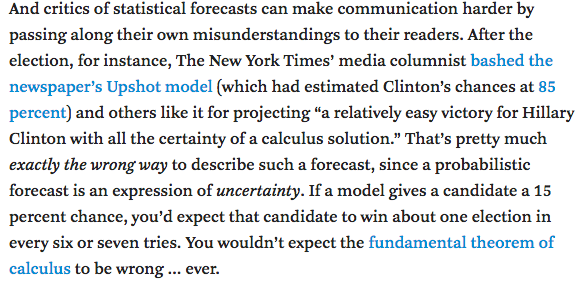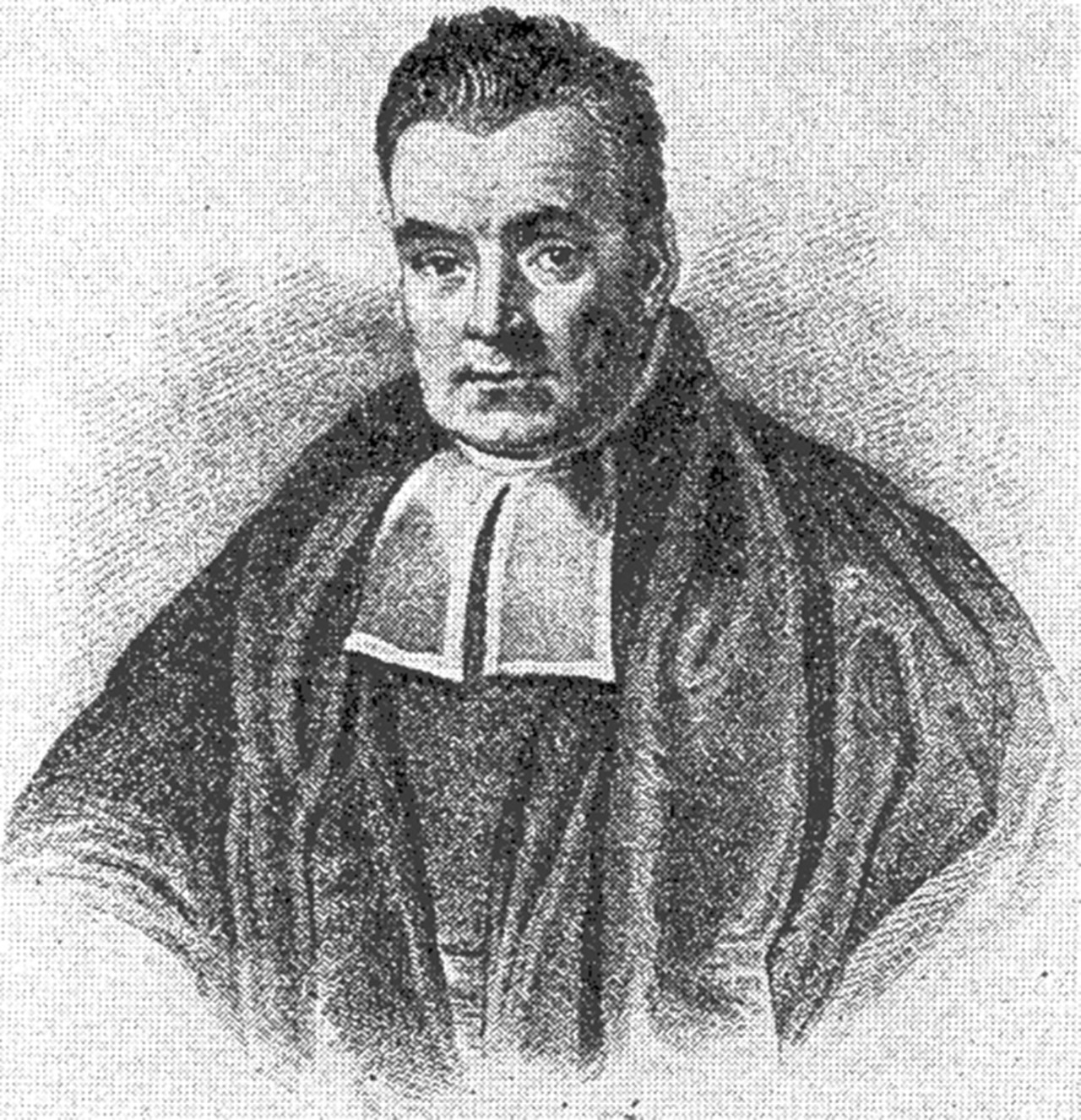class: center, middle, inverse, title-slide # Week 10 - Probability ## Axioms, Permutations and Combinations <html> <div style="float:left"> </div> <hr color='#EB811B' size=1px width=800px> </html> ### Danilo Freire ### 1 April 2019 --- <style> .remark-slide-number { position: inherit; } .remark-slide-number .progress-bar-container { position: absolute; bottom: 0; height: 6px; display: block; left: 0; right: 0; } .remark-slide-number .progress-bar { height: 100%; background-color: #EB811B; } .orange { color: #EB811B; } </style> # Chapter 6 - Probability .font150[ * Probability axioms * Conditional probability * Bayes' theorem * Law of large numbers * Probability distributions ] --- # Today's Agenda .font150[ * Frequentist and Bayesian probability frameworks * The three probability axioms * Permutations * Combinations ] --- # Why Probability? .font150[ * .orange[Probability rules our lives] ] -- .font150[ * It is everywhere ] -- .font150[ * However, humans are _really bad_ at interpreting probabilities * Even worse at calculating (estimating) probabilities ] --- # Why Probability? .center[] --- # Why Probability? .center[] .font150[ More at <https://fivethirtyeight.com/features/the-media-has-a-probability-problem/> ] --- # Why Probability? .font150[ * What are the chances it rains tomorrow? * What are the chances you win the lottery? * What is the probabilty of getting an A in POLS1600? ] --- # What Is Probability .font150[ * A mathematical model of uncertainty (chance) * Preview: later we will use probability to make statements about uncertainty in data analysis (chapter 7) ] --- # Two Concepts of Probability .font150[ * .orange[Frequentist]: long-run frequency of events - Ratio between the number of times the event occurs and the number of trials - Example: coin flips ] -- .font150[ * .orange[Bayesian]: subjective belief about the likelihood of event occurrence - Evidence based belief - Often more sensible philosophy in political world ] --- # Thomas Bayes .center[] .font150[ <https://en.wikipedia.org/wiki/Thomas_Bayes> ] --- # The Theory That Would Not Die .center[] --- # Egon Pearson .center[] .font150[ <https://en.wikipedia.org/wiki/Egon_Pearson> ] --- # Ronald Fisher .center[] .font150[ <https://en.wikipedia.org/wiki/Ronald_Fisher> ] --- # Important Terms .font150[ * .orange[Experiment]: an action or a set of actions that producestochastic events of interest - coin toss, rolling a die, voting in an election * .orange[Sample Space] `\((\Omega)\)`: all possible outcomes of the experiment - {heads, tails}, {1,2,3,4,5,6}, {abstain, Clinton, Trump} * .orange[Event]: subset of sample space - tails, 1, vote for Trump ] --- # Example .font150[ What is the experiment, sample space, and one event for coin flips or pulling a single card out of a deck of 52? ] --- # Example .font140[ Probability of event A `\(= P(A) = \frac{\text{number of elements in A}}{\text{number of elements in sample space}}\)` Probability of heads `\(= P(H) = \frac{heads}{heads + tails} = \frac{1}{2}\)` ] -- .font140[ What is the probability of 3 heads in 3 flips? Sample space?] -- .font140[ `$$\Omega = \{HHH,HHT,HTH,THH, HTT, THT, TTH, TTT\}$$` What is the event space we are interested in?] -- .font150[ `$$\{HHH\}$$` ] --- # Example .font140[ What is the probability of 3 heads in 3 flips? `$$P(3 H) = \frac{\{HHH\}}{\{HHH,HHT,HTH,THH, HTT, THT, TTH, TTT\}}$$` `$$P(3 H) = \frac{1}{8}$$` ] --- # Another Example .font140[ What is the probability of at least 2 heads in 3 flips? Sample space?] -- .font140[ `$$\Omega = \{HHH,HHT,HTH,THH, HTT, THT, TTH, TTT\}$$` What is the event space we are interested in?] -- .font140[ `$$\{HHH, HTH, THH, HHT\}$$`] -- .font140[ `$$P(2 H) = \frac{4}{8}$$` ] --- # Axioms (Rules) of Probability .font140[ From 3 axioms, the entire probability theory can be built ] .font140[ * Probability of any event is non-negative: `$$P(A) \ge 0$$` * Prob. that one of the outcomes in the sample space occurs is 1 `$$P(\Omega) = 1$$` * .orange[Addition Rule:] If events A and B are mutually exclusive (_meaning only one can happen at a time_), then `$$P(A\ \textsf{or}\ B) \ = \ P(A) + P(B)$$` ] --- # Useful Rules of Probability .font150[ * `\(A^c\)` - complement to A, i.e. part of sample space not in A * Sometimes it is easier to calculate the probability of an event by using its complement ] --- # Useful Rules of Probability .font150[ What is the probability of having at least one tails in 3 coin flips?] -- .font150[ `$$\Omega = \{HHH,HHT,HTH,THH, HTT, THT, TTH, TTT\}$$`] -- .font150[ P(at least one T) = `\(\frac{7}{8}\)` P(at least one T) = `\(1 - P(HHH) = 1 - \frac{1}{8}\)` ] --- # Example .font150[ What is the probability of getting a Queen as the first card from a full deck? `$$\Omega = ?$$`] -- .font150[ `$$P(Queen) = \frac{4}{52} = \frac{1}{13}$$` ] --- # Permutation: When Order Matters .font150[ * Often we do not want to or can't write out all possible combinations by hand * How many possibilities are there to arrange letters A,B,C?] -- .font150[ * Three outcomes: A, B, C and three draws] -- .font150[ * First draw: A, B, or C * Second draw: two possibilities * Third draw: one left * 3 x 2 x 1 possibilities ] --- # Permutation .font150[ * Permutations count many ways we can .orange[order] _k_ objects out of a set of _n_ unique objects `$$_{n}P_{k} = n \times (n-1) \times (n-2) \times ... \times (n-k + 1) = \frac{n!}{(n-k)!}$$` * What does _n!_ stand for?] -- .font150[ * n! = n-factorial = `\(n \times (n-1) \times (n-2) \times ... \times (n-n+1)\)` * `\(3! = 3 \times 2 \times 1\)` * .orange[Note:] `\(0! = 1\)` ] --- # Permutation Example .font150[ * How many ways can we arrange four cards out of the 13 spades in our card deck? ] -- .font150[ * first draw = ? ] -- .font150[ * `\(13 \times 12 \times 11 \times 10\)`] -- .font150[ * `\(\frac{13!}{(13-4)!} = \frac{13!}{9!} = \frac{13 \times 12 \times 11 \times ... \times 2 \times 1}{9 \times 8 \times ... \times 2 \times 1} =\)` * `\(13 \times 12 \times 11 \times 10 = 17,160\)` ] --- # Combinations .font140[ * Combinations are similar to permutations, except that the ordering doesn't matter * So with respect to combinations of 3 out of 26 letters, ABC, BAC, CAB, etc are the same * There are .orange[always] fewer combinations than permutations * Draw 2 out of letters ABC. Permutations: ] -- .font140[ * AB, AC, BA, BC, CA, CB = `\(\frac{3!}{1!}\)` * Combinations:] -- .font140[ * AB, AC, BC ] --- # How to Calculate Combinations .font150[ * Calculate permutations and then account for the fact that we overcounted due to ordering * Get rid of counts of different arrangements of same combination: divide by `\(k!\)` * `\(_{n}C_{k} = {n \choose k} = \frac{_{n}P_{k}}{k!} = \frac{n!}{k!(n-k)!}\)`] -- .font150[ * Why divide by `\(k!\)` ?] -- .font150[ * for two sampled elements, we have `\(2!(= 2×1 = 2): A, B = AB, BA\)` ] --- # Combination Example: Winning the Lottery .font150[ * What is the probability of winning (simplified) Mega Millions? * Pick five numbers between 1 and 70 * Probability of getting 5 correct? * Size of the sample space? ] -- .font120[ `$${70 \choose 5} = \frac{70!}{5! \times (70-5)!} = \frac{70!}{5! \times 65!}$$` ] -- .font120[$$12,103,014$$] --- # How To Solve in R .font150[ * Just use the `choose()` function: ```r choose(70, 5) # from 70 numbers, choose 5 ``` ``` ## [1] 12103014 ``` ] --- class: inverse, center, middle # Questions? <html><div style='float:left'></div><hr color='#EB811B' size=1px width=720px></html> --- class: inverse, center, middle # See you in a bit! <html><div style='float:left'></div><hr color='#EB811B' size=1px width=720px></html>